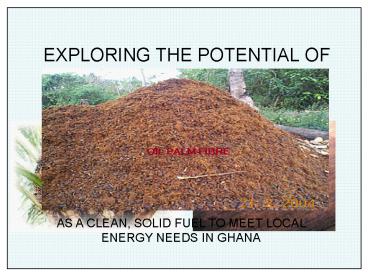EXPLORING THE POTENTIAL OF - PowerPoint PPT Presentation
1 / 29
Title: EXPLORING THE POTENTIAL OF
1
EXPLORING THE POTENTIAL OF
OIL PALM FIBRE
AS A CLEAN, SOLID FUEL TO MEET LOCAL ENERGY NEEDS
IN GHANA
2
AIM OF PROJECT
Investigate the potential of Oil Palm fibre as
clean supplementary or substitute fuel for
domestic utilization in Ghana
- How the preparation or modification of the fibre
affects its characteristics hence what
modification results in cleaner product
- Data on oil palm behaviour physical and chemical
3
LITERATURE REVIEW
OIL PALM (Elaeis Guineensis)
- Uses of Fibre
- Industrial
- Main use as boiler fuel for almost all palm
oil processing companies - Domestic
- Use is from survey of some Ghanaian households
About 72-76 of fresh fruit Bunch comes out at
various stages of the process as waste.
www.fao.org/DOCREP/005/Y4355E/Y4355E00.HTM
4
Uses of fibre at HH level
Main problems SMOKINESS Low combustion
efficiency
DIRECT COMBUSTION
5
Biomass briquettes recognised as substitute for
fuel wood but..
the set back is due to the technical constraints
involved, the lack of knowledge to adapt the
technology to suit local conditions, and the
numerous failures of briquetting machines in
almost all developing countries.
conceived as projects undertaken by developmental
agencies rather than businesses very few
exceptions?
the prices of charcoal and firewood are often too
low that modern technologies, however efficient
they may be, often find it difficult to compete
with traditional practices.
The briquetting of Agricultural waste for fuel,
Eriksson Prior, www.fao.org/docrep/T0275E/T0275E
00.htm Briquetting as alternative to wood
fuel, Robert. J. Vander Plas, http//ourworld.comp
userve.com/homepages/marge_fr/BUDP.html
6
DEFINING THE PATH
- Competitive/ low cost fuel
- Simple technology
- Socially accepted
- Require minimum or no modification to existing
cooking device
Cleanliness test for CO, CO2, CH4
smoke?
7
DENSIFICATION TECHNOLOGY
- Fuel characteristics depend on
- Properties of Raw material
- The shape/size of the individual briquettes
- The density of the individual briquettes
Density influenced by type of equipment and
moisture content
Moderate pressure 0.2 5MPa High pressure gt
100Mpa density of 1200-1400Kg/m3 Ultimate
limit -1,450 1,500 kg/m³ Biomass lowest
density -40Kg/m3 highest 250 Kg/m3
8
METHODOLOGY
- Survey energy use at house hold level
- Investigate availability of fibre
- Seek reaction/perception of briquetted waste for
fuel
QUESTIONAIRE
Aim
LABORATORY TESTS
- COMBUSTION BEHAVIOUR OF LOOSE FIBRE
- PREPARE BRIQUETTES
- BURN BRIQUETTES
- - Stand alone
- Charcoal bed
- Pumice bed
9
Methodology cont. Preparation of briquettes
- DRY FIBRE BRIQUETTES
- Moisture content approx. 7
- with and without binders
- DECOMPOSED FIBRE BRIQUETTES
- 6 Weeks
- Moisture content approx. 58
- Hydraulic pressed/hand moulded
- VARIABLES
- PRESSURE
- HOLD TIME
- LENGTH ?
10
Normal look
DFB no binders
With binder
11
Rod-like HMB
Pan cake HMB
Spherical HMB
12
Combustion of loose fibre vs briquette
- 120g loose of fibre
- Very big flame
- Burn time 4 mins 35 secs
- Burn rate 0.45g/s
Varies 11-25mins 14-21g
30 times slower
About 6x more
- 18.21g DFB
- 20.15mins
- Rate 0.015g/s
13
Results Combustion of Dry Fibre Briquette
Peaks should be an indication of no. of re-fuel
charge within the series
1840
55.4
1640
Frequent dying out of fire D E
30.2
30.1
845
C
B
296
A
14
Combustion of decomposed HPB
Peaks should be an indication of no. of re-fuel
charge within the series
15
Combustion of decomposed HMB
Peaks should be an indication of no. of re-fuel
charge within the series
16
Comparing flames of Decompose fibre briquettes
and charcoal
17
TRIAL TEST Charcoal bed combustion
Peaks should be an indication of no of re-fuel
charge within the series
Briquette effect or fan effect?
B1
B2
Increased extraction velocity i.e. 0.46 0.62m/s
Add briquette
18
Observations from Charcoal Bed Combustion Test
Peaks should be an indication of no. of re-fuel
charge within the series
10 min Recharge briquette
5 mins Recharge
10 min s Recharge
Start charge 250g Refuel charge 100g
19
Observations from Charcoal Bed Combustion Test
Peaks should be an indication of no. of re-fuel
charge within the series
67mins
67mins
117.6g
175.42g
17mins
Short term 15 mins 15000 200 Long term 8 hrs
TWA 5000 30
20
Observations from Pumice Bed Combustion Test
21
Observations from Pumice Bed Combustion Test
22
Observations from Pumice Bed Combustion Test
23
Observations from Pumice Bed Combustion Test
24
Comparing Results different briquettes/different
combustion methods
25
Comparing Results
26
(
Just a rough idea..
Energy required to bring 1 litre of water (1Kg)
to boil 305KJ Implies 0.018 0.027Kg of
Palm Fibre 0.01-0.009Kg of charcoal
ASSUMPTION IS THAT FIBRE WOULD HAVE A COMBUSTION
RATE THRICE OF CHARCOAL AND THAT COMBUSTION AND
THERMAL EFFICENCIES ARE NOT CONSIDERED
76 briquettes would be about 1.368Kg enough to
boil 50-77 litres of water at 100 efficiency
and 5-8 litres at 10 efficiency i.e.
efficiencies of open fire
100 households _at_10 efficiency saving on 45.6Kg
of charcoal/week, _at_14 efficiency of production,
would save 318 -638Kg of wood. Reduction in CO2
43-71Kg.
Emission factor used for charcoal (970-1600g/Kg)
was at 48-57 efficiency compared to 14
efficiency of traditional kilns in Ghana
www.euronatur.org/info_english/stove.PDF
27
CONCLUSION
- Briquetting of fibre
- preferable option to burning the loose fibre
- presents a better option in the light of the
total production process of charcoal
In terms of cleanliness, combustion efficiency
and possibly heat transfer efficiency reference
to loose fibre
Advantage of the briquette over the loose fibre
asides the longer and comparatively smokeless
burning was more towards CO2 reductions.
A charcoal-briquette pollutant ratio of a minimum
of 157 existed for CO and 80 for CO2.
Socially acceptable and has a sustainable
sourcing
28
INTRODUCTION
RECOMMENDATION
Combustion methods used be investigated again and
a water boiling test be performed.
Percentage difference in emission factor of
briquette and charcoal was so high in favour of
briquette that it calls for further investigation.
29
THANK YOU
Irene Darku, 2004































